Business process modeling: Difference between revisions
m (→Links) |
|||
| Line 122: | Line 122: | ||
* [http://www.wfmc.org/ WfMC] (the Workflow Management Coalition), Founded in 1993, the Workflow Management Coalition (WfMC) is a global organization of adopters, developers, consultants, analysts, as well as university and research groups engaged in workflow and BPM. The WfMC creates and contributes to process related standards, educates the market on related issues, and is the only standards organization that concentrates purely on process. | * [http://www.wfmc.org/ WfMC] (the Workflow Management Coalition), Founded in 1993, the Workflow Management Coalition (WfMC) is a global organization of adopters, developers, consultants, analysts, as well as university and research groups engaged in workflow and BPM. The WfMC creates and contributes to process related standards, educates the market on related issues, and is the only standards organization that concentrates purely on process. | ||
* [http://www.omg.org/ OMG] (the Object Management Group), an international, open membership, not-for-profit computer industry consortium since 1989. OMG’s modeling standards, including the Unified Modeling Language ([[UML]]), Model Driven Architecture (MDA). OMG works in liaison with other organizations such as WfMC and also is an ISO submitter. | * [http://www.omg.org/ OMG] (the Object Management Group), an international, open membership, not-for-profit computer industry consortium since 1989. OMG’s modeling standards, including the Unified Modeling Language ([[UML]]), Model Driven Architecture (MDA). OMG works in liaison with other organizations such as WfMC and also is an ISO submitter. | ||
* [http://bpmi.org/ BPMI], the Business Process Management Initiative, merged in 2005 their Business Process Management activities with OMG. | |||
; Other | ; Other | ||
Revision as of 16:39, 25 June 2010
<pageby nominor="false" comments="false"/>
Introduction
Business process modeling (BPM) refers to the modeling of activities performed within an organization. Typically, an activity is viewed as a workflow or process composed of events, activities, gateways and (sometimes) other elements. More precisely a “business process [can be defined] as a collection of related, structured activities or tasks that produce a specific service or product (serve a particular goal) for a particular customer or customers” (Wikipedia, retrieved June 23 2010). However, business process modeling is also used in other areas, e.g. in government organization such as the US department of defense or in e-science.
BPM also may refer to business process management' for which business process modeling can be a tool.
“Business process modeling (BPM) in systems engineering and software engineering is the activity of representing processes of an enterprise, so that the current process may be analyzed and improved” (Wikipedia, retrieved June 23 2010). In other words, BPM is often related to (business) reengineering and even more substantial change management.
We can distinguish between three main types of processes and relate these to education.
- Management processes, e.g. organizational governance, conducting a large research project or a training program.
- Operational processes, e.g. plan and conduct a research project, define and enact a pedagogical scenario.
- Supporting processes, e.g. technical support (network, file servers, e-mail, etc.) or human resource management (authors, experts, tutors, etc.)
See also: enterprise architecture framework, workflow, BPMN (a typical notation language for process modeling) and BPEL
Process management systems
While educational technologists are probably most interested by workflow management systems, there exist a variety of tools that can be subsumed under the label of Business process management systems (BPMS).
According to Shapiro and Genrich, an improvement (re-engineering) process can be characterized as the following set of steps:
- Analyze the historical (or simulation) data to determine where improvements are needed. If the evaluation is satisfactory, stop.
- From the data, come up with an idea for improvement.
- Create a simulation scenario incorporating that idea and run a simulation.
- Evaluate the results to determine whether it has resulted in improvement and repeat the cycle.
“Business Process Management Systems are a rich source of events that document the execution of processes and activities within these systems. Business Process Analytics is the family of methods and tools that can be applied to these event streams in order to support decision-making in organizations. The analysis of process events can focus on the behavior of completed processes, evaluate currently running process instances, or focus on predicting the behavior of process instances in the future.” (Shapiro and Muehlen, 2008:Abstract, retrieved 10:33, 25 June 2010 (UTC)).
Shapiro and Muehlen (2009) identify two strategic perspectives for business analytics: (1) Performance: improve reaction time and evaluation of decisions and (2) Compliance: adherence of process execution with rules and insurance of contractual obligations. In an temporal perspective: “To evaluate what has happened in the past, to understand what is happening at the moment, or to develop an understanding of what might happen in the future.” (p.2). Various related analytical perspectives are known as Process Controlling, Process Mining, Business Activity Monitoring, Process Intelligence, etc.
Taylor (2010) identifies four different kinds of analytical insight: business intelligence (what is happening, who are my customers), descriptive analysis (what is the profile of my best customers), predictive analysis (how will X behave in the future) and optimization simulation (how can I extract maximum value from an investment).
List of BPMS components
Shapiro and Genrich identify the following elements that may be part of a complete BPMS solution:
- Analytics
- Storage and processing of operations data to provide useful business information.
- Business Activity Monitoring (BAM)
- Real time depiction of Key Performance Indicators (KPIs) and generation of alerts etc.
- Data Miner
- Statistical processing of business information to extrDocument Number TC00-1003act patterns, detect trends and make predictions.
- Event Stream
- Flow of information packets about meaningful state changes. The log events generated by currently running processes are an example.
- Execution Engine
- Any business process enactment service, including workflow engines, BPEL executor, Enterprise resource planning (ERP) system etc.
- Optimizer
- A software tool that utilizes the Data Miner and/or Simulator to make recommendations for changes to business operations.
- Rules Engine
- A software system that helps manage and automate business rules. Used to detect interesting business situations automatically.
- Simulator
- Supports what-if analysis of current or planned operations.
Use in education
As far as educational technology is concerned, we could identify two main sources of inspiration and technologies that could be repurposed:
- All sorts of techniques to monitor learning activities and student progress
- Techniques for modelling educational scenarios, i.e. the equivalent of educational modeling languages and educational design languages as developed for instance in the domain of learning design.
- Obviously, use/adapt these management techniques to run educational institutions and programs.
Workflows and processes
Business Processes (as opposed to manufacturing processes for example) “set of one or more linked procedures or activities which collectively realize a business objective or policy goal, normally within the context of an organizational structure defining functional roles and relationships.” (Swenson, 2007
A business process model defines workflows in terms of activities (steps) and transitions (transitions between steps).
“Workflow is concerned with the automation of procedures where documents, information or tasks are passed between participants according to a defined set of rules to achieve, or contribute to, an overall business goal. Whilst workflow may be manually organised, in practice most workflow is normally organised within the context of an IT system to provide computerised support for the procedural automation. [...] Workflow is often associated with Business Process Re-engineering, which is concerned with the assessment, analysis, modelling, definition and subsequent operational implementation of the core business processes of an organisation (or other business entity). [...] A Workflow Management System is one which provides procedural automation of a business process by management of the sequence of work activities and the invocation of appropriate human and/or IT resources associated with the various activity steps.” (The Workflow Reference Model, 1995:6])
The WfMC workflow reference model characterizes a workflow mangement system (1995:6-7) (WFM) system as providing support in three functional areas:
- the Build-time functions, concerned with defining, and possibly modelling, the workflow process and its constituent activities
- the Run-time control functions concerned with managing the workflow processes in an operational environment and sequencing the various activities to be handled as part of each process
- the Run-time interactions with human users and IT application tools for processing the various activity
The following figure illustrates the basic characteristics of WFM systems and the relationships between these main functions:
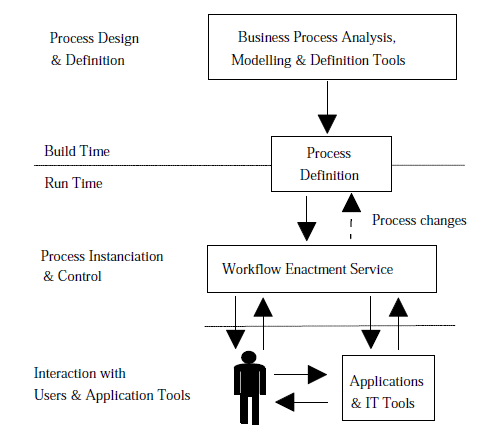
The WfMC workflow reference model also includes a a generic workflow product structure model that includes three components:
- software components which provide support for various functions within the workflow system (shown in dark fill)
- various types of system definition and control data (shown unfilled) which are used by one or more software components
- applications and application databases (shown in light fill) which are not part of the workflow product, but which may be invoked by it as part of the total workflow system
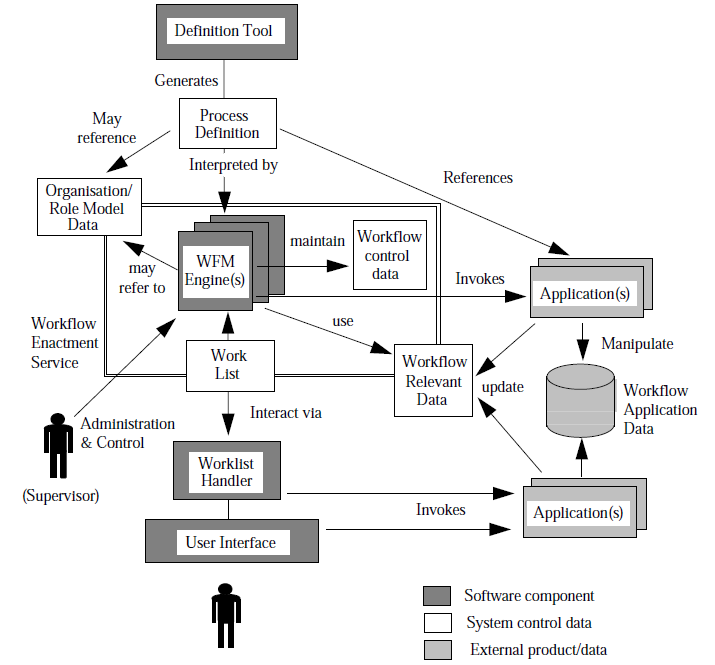
In a different more operational view the WfMC workflow reference model (1995:21-25) defined the following list and figure define the major components
- Workflow Enactment Service: A software service that may consist of one or more workflow engines in order to create, manage and execute workflow instances. Applications may interface to this service via the workflow application programming interface (WAPI).erface withing the workflow architecture.
- Workflow Engine: A software service or "engine" that provides the run time execution environment for a workflow instance
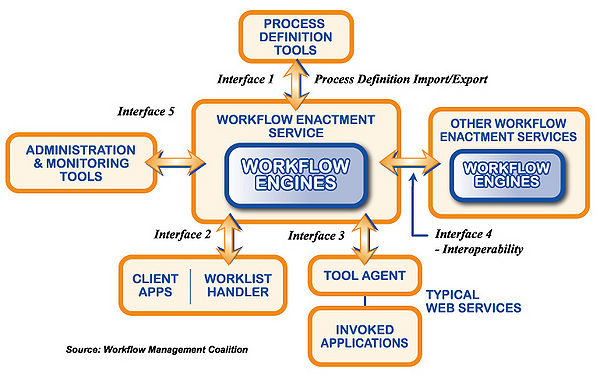
The five interfaces defined are the following:
- Interface 1: exchange of process definition data between BPR tools, workflow systems and process definition repositories
- Interface 2: client application integration with different workflow systems, defined as a series of workflow APIs
- Interface 3: a common framework for 3rd parties to integrate other industry applications & services
- Interface 4: Interoperability with other enactment systems
- Interface 5: audit and administration of workflow cases across systems
A more recent informal document, The workflow reference model - 10 years on - presents a BPM component modeling terms of a development/execution view. The top half defines the definition process of a business model and the lower half its enacment.
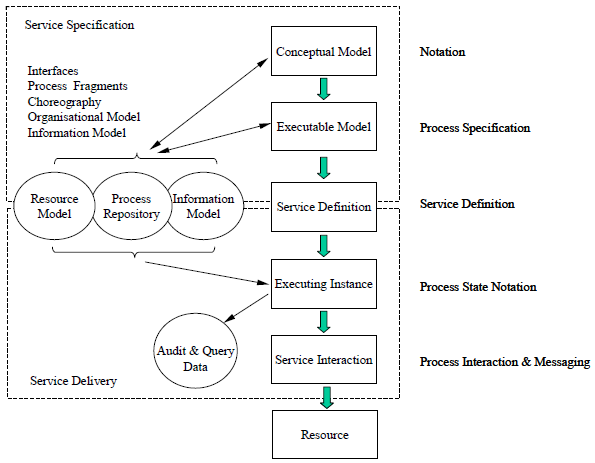
Finally, the model (p30) also includes an interesting process definition meta-model of the kind that could be useful for the implementation of learning design engines.

See also e-science, so far the only academic practice that strongly relies on IT for organizing workflows for research in the narrow (interesting) sense.
Standards
Many standards are related to BPM and workflow. The most important business process modeling standards define process semantics, i.e. XPDL and BPMN, and BPEL.
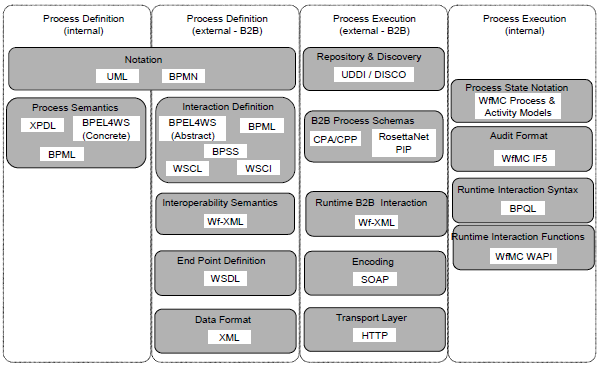
Links
- Overviews
- Enterprise modeling, the abstract representation, description and definition of the structure, processes, information and resources of an identifiable business, government body, or other large organization.
- Business process modeling, the activity of representing processes of an enterprise, so that the current process may be analyzed and improved.
- BPMN Industry update, by Rober Shapiro, 2010.
- Players that define standards
- WfMC (the Workflow Management Coalition), Founded in 1993, the Workflow Management Coalition (WfMC) is a global organization of adopters, developers, consultants, analysts, as well as university and research groups engaged in workflow and BPM. The WfMC creates and contributes to process related standards, educates the market on related issues, and is the only standards organization that concentrates purely on process.
- OMG (the Object Management Group), an international, open membership, not-for-profit computer industry consortium since 1989. OMG’s modeling standards, including the Unified Modeling Language (UML), Model Driven Architecture (MDA). OMG works in liaison with other organizations such as WfMC and also is an ISO submitter.
- BPMI, the Business Process Management Initiative, merged in 2005 their Business Process Management activities with OMG.
- Other
- 2010 BPM & Workflow Handbook (4 free chapters for download).
- Tools
- To do
References
- Hollingsworth, David (1995), The Workflow Reference Model, Workflow Management Coalition, Document Number TC00-1003, Abstract/download.
- zur Muehlen, M.; Shapiro, R.: Business Process Analytics. In: Rosemann, M.; vom Brocke, J.: Handbook on Business Process Management, Vol. 2, Springer Verlag, Berlin et al. 2009. PDF preprint
- zur Muehlen, M. (2004) Workflow-based Process Controlling. Foundation, Design, and Implementation of Workflow-driven Process Information Systems. Berlin: Logos.
- Shapiro, Robert (2008). Integration of Workforce Management with a Business Process Management Suit in BPM and Workflow Handbook, Future Strategies Inc.
- Shapiro, Robert M. and Hartmann Genrich, The Auto Optimizer, Global 360, United States, PDF
- Shapiro, Robert M. (2006). XPDL 2.0: Integrating Process Interchange and BPMN, in Fischer, Layna (ed.), 2006 BPM and Workflow Handbook, Future Strategies Inc. PDF reprint
- Taylor (2010), Intelligent, Automated Processes: Embedding Analytics in Decisions, in Fischer, Layna (ed.) 2010 BPM and Workflow Handbook, Spotlight on Business Intelligence, FutStrat. PDF reprint
- Swenson Keith (2007). The Business Value of Workflow and BPM, in Fischer, Layna (ed.) 2007 BPM & Workflow Handbook FutStrat. [PDF reprint